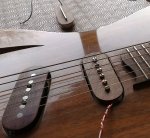muttley600
Banned
The other day I was gigging with a pickup band and took along the HR guitar we all put together last year. The more I played it the more I got to thinking of that Charlie Christian sound that comes from that ES 150 monstrosity.. I want to work on getting it closer.
The pickup that put me in mind of the CC tone was the front PAF style that you cooked up, played clean through a Fender Princeton mostly flat with a touch of plate reverb.
The pickup was your spec and from memory was AlNiCo 5 CCW north up, 9,500 turns 42 awg with moderate scatter scatter built P90 style. I know the original CC pickups had hunking great cobolt magnets and used 38AWG wire with a bar instead of poles.
Question is what would you change to try and get it closer to that elusive Christian tone? It's going to go on an old Jazz box I made years ago about the same size as the ES150...
Any other observations would be good.
The pickup that put me in mind of the CC tone was the front PAF style that you cooked up, played clean through a Fender Princeton mostly flat with a touch of plate reverb.
The pickup was your spec and from memory was AlNiCo 5 CCW north up, 9,500 turns 42 awg with moderate scatter scatter built P90 style. I know the original CC pickups had hunking great cobolt magnets and used 38AWG wire with a bar instead of poles.
Question is what would you change to try and get it closer to that elusive Christian tone? It's going to go on an old Jazz box I made years ago about the same size as the ES150...
Any other observations would be good.









